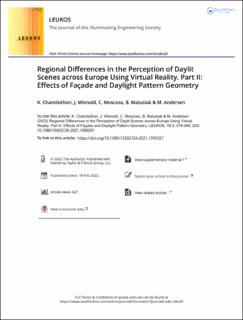| dc.description.abstract | While there is a growing use of complex façade designs in contemporary architecture worldwide and across Europe, little is known about the perceptual effects of these façades and the resulting daylight patterns on occupants, or about how such effects might differ between European latitudes. This study examines the perception of façade and daylight patterns across Europe by replicating a virtual reality (VR) experiment in Norway, Switzerland and Greece, using a mixed experimental design to jointly investigate the influence of different factors on the perception of a daylit interior space. These factors included: façade geometry (within-subject factor with four contemporary façade designs of equal aperture ratio), sky type (clear sky with high or low sun angle, or overcast sky), spatial context (socializing or working), and country (Norway, Switzerland, or Greece). Results showed that, among the manipulated factors, only the façade geometry affected the studied attributes (how pleasant, interesting, exciting, calming, complex, spacious, and bright the space was perceived, and the satisfaction with the amount of view in the space). Regional effects were observed only for reported brightness, with higher evaluations from participants in Greece than in Norway, but are difficult to generalize due to limitations stemming from the use of VR and the conduction of experiments in different seasons (summer and early fall) in the two countries. These findings show that façade design is a crucial feature in our spatial experience, inducing equivalent perceptual effects, such as changes in pleasantness or interest, across Europe, and motivate further research on the perception of brightness. | en_US |

